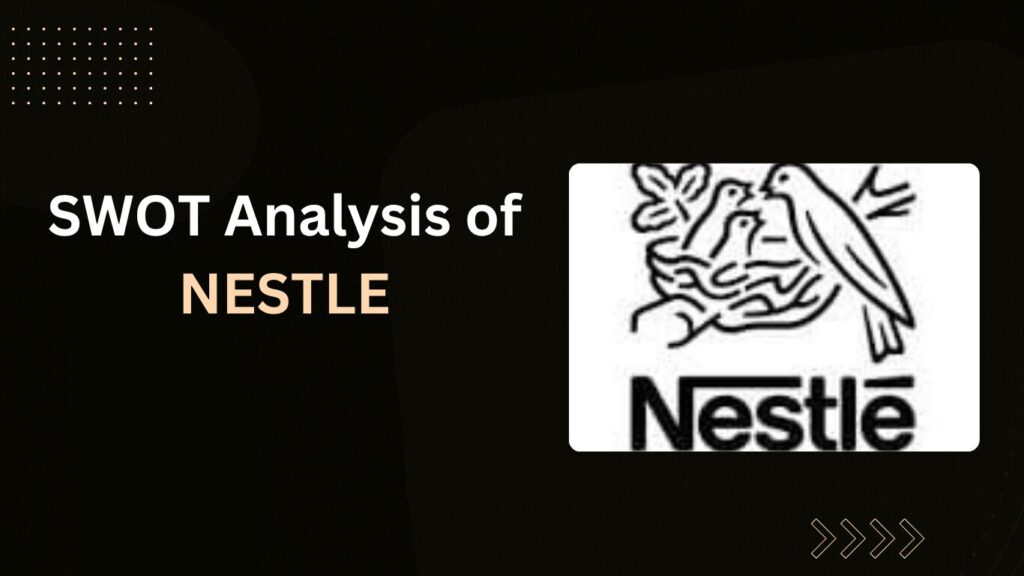Nestlé, a name synonymous with global excellence in the food and beverage industry, has carved an indelible mark since its inception in 1866. Headquartered in Vevey, Switzerland, the company stands as one of the world’s leading nutrition, health, and wellness enterprises. With its extensive product portfolio and commitment to innovation, Nestlé remains a household name across continents.
In an era marked by rapid technological advancements, changing consumer behaviors, and environmental challenges, it becomes imperative to assess a company’s internal strengths and weaknesses, along with external opportunities and threats. This is where a comprehensive SWOT analysis of Nestlé plays a pivotal role. Such an analysis provides strategic insights into how Nestlé can leverage its capabilities and counter challenges to maintain its market leadership.
Company Overview
Founded by Henri Nestlé in 1866, the company started with a single product—an infant cereal that saved a child’s life. Over the decades, it has evolved into a behemoth operating in more than 190 countries. Nestlé’s portfolio includes some of the most recognized brands such as Nescafé, KitKat, Maggi, Purina, Nestlé Waters, Gerber, and Nestlé Health Science.
The company has continuously emphasized sustainability, innovation, and digital transformation to adapt to the evolving global landscape. In recent years, Nestlé has committed to achieving net-zero greenhouse gas emissions by 2050 and reducing its carbon footprint through various sustainable initiatives. Their push toward plant-based products and recyclable packaging are steps in the right direction.
| Industry | Food and Beverage |
| Founded | 1866 |
| Founder | Henri Nestlé |
| Headquarters | Vevey, Switzerland |
| Area Served | Worldwide |
| Current CEO | Mark Schneider |
| Revenue | CHF 68.8 billion (as of Q3, 2023) |
| Net Income | CHF 5.6 billion (2023) |
| Number of Employees | Approximately 275,000 |
| Market Capitalization | $307.73 Billion (as of January 2024) |
| Website | https://www.nestle.com/ |
Strengths
Diverse Brand Portfolio
One of the biggest strengths in the SWOT analysis of Nestlé company is its expansive brand portfolio. With over 2,000 brands under its umbrella, Nestlé caters to a broad spectrum of consumer needs ranging from nutrition and health to indulgence and convenience.
Example: Brands like Maggi dominate the instant noodle market in India, while Nescafé leads in the global coffee segment. KitKat has become an iconic confectionery product worldwide.
Global Presence
Nestlé’s operations span across 190+ countries, offering them a diversified revenue stream and minimizing regional market risks. This global footprint allows the company to localize products based on cultural preferences.
Example: In India, Nestlé India has adapted products like Maggi to include local flavors such as Masala and Chicken, which appeal directly to the Indian palate.
Strong Financial Performance
The company continues to show robust financial health. In 2022, Nestlé reported an 8.4% increase in sales, reaching CHF 94.4 billion. This consistent revenue growth highlights its resilience and operational efficiency.
Example: During the COVID-19 pandemic, while many companies saw a slump, Nestlé experienced growth in its health science and pet care segments.
Robust R&D Capabilities
Nestlé’s commitment to innovation is evident through its heavy investment in Research and Development. The company runs 23 R&D centers worldwide, continuously improving product formulations and exploring new health solutions.
Example: The development of sugar-reduction technology without compromising taste is a breakthrough aimed at tackling obesity and diabetes issues.
Efficient Distribution Network
Nestlé has built a seamless supply chain and distribution system that ensures product availability in the remotest of areas. Their network ensures timely delivery, high product visibility, and strong retail penetration.
Example: In India, Nestlé has built a distribution model that reaches even Tier 3 towns and rural markets, supporting its widespread product availability.
Weaknesses
Dependence on Key Markets
A considerable portion of Nestlé’s revenue comes from the U.S. and Europe. While these are stable markets, overdependence can be risky due to economic downturns or regulatory changes in those regions.
Example: The inflationary pressures in Europe and the U.S. in recent years have slightly affected Nestlé’s pricing strategies and profit margins.
Negative Publicity
Nestlé has faced criticism and legal challenges over the years related to child labor, water resource exploitation, and unethical marketing practices.
Example: In the early 2000s, Nestlé was embroiled in a controversy for promoting infant formula in developing countries in ways deemed unethical. This incident significantly tarnished its global image.
Complex Organizational Structure
Being a giant conglomerate, Nestlé’s vast organizational structure can lead to bureaucratic red tape, delaying decision-making and slowing innovation.
Example: The delay in launching certain health-based products in emerging markets can be attributed to the multiple layers of approval within the organization.
Opportunities
Emerging Markets
Emerging economies in Asia, Africa, and Latin America present enormous growth potential for Nestlé due to rising disposable incomes and urbanization.
Example: Nestlé India reported a 13.8% year-on-year growth in 2023, fueled by rural expansion and product diversification.
E-commerce Growth
With the boom in online shopping, Nestlé has immense opportunities to expand through e-commerce platforms. Digital sales are becoming a crucial revenue stream.
Example: Nestlé has partnered with platforms like Amazon, BigBasket, and Flipkart to improve its online presence in India.
Health and Wellness Trends
The growing global focus on fitness, nutrition, and well-being aligns perfectly with Nestlé’s product innovation in the health segment.
Example: The launch of low-sugar, high-protein, and plant-based products has been a game-changer in appealing to health-conscious consumers.
Sustainability Initiatives
Sustainability has become a significant buying criterion for consumers. Nestlé’s continued investment in eco-friendly practices not only helps the environment but also enhances brand loyalty.
Example: Nestlé plans to make all its packaging recyclable or reusable by 2025 and has invested in alternative materials and circular economies.
Threats
Intense Competition
Nestlé faces fierce competition from both global giants like Unilever, PepsiCo, and Kraft Heinz and regional players in various segments.
Example: In the instant noodles segment in India, Maggi competes with brands like Yippee and Knorr, which are aggressively capturing market share.
Changing Consumer Preferences
Consumers today are quick to switch brands based on health trends, ingredients, or ethical concerns. This necessitates constant product innovation.
Example: The demand shift toward organic and clean-label products has led Nestlé to reformulate several existing items to meet new expectations.
Regulatory Challenges
Operating across so many countries means dealing with a wide array of food safety, packaging, and advertising regulations.
Example: In 2015, Nestlé India had to withdraw Maggi noodles from the market due to regulatory concerns over lead content, causing massive financial and reputational damage.
Supply Chain Disruptions
Global events like pandemics, wars, and natural disasters can disrupt Nestlé’s supply chain, affecting production and delivery.
Example: The COVID-19 pandemic initially impacted ingredient sourcing and logistics, forcing Nestlé to rethink its supply chain resilience.
Competitors of Nestlé
Nestlé, known for its iconic brands like Milo, Maggi, Nescafé, and KitKat, operates in a fiercely competitive global food and beverage market. Its dominance is constantly challenged by several key players through aggressive pricing, innovation, and strategic marketing. Let’s take a look at Nestlé’s top competitors:
Unilever
Unilever is a strong competitor to Nestlé, especially in ice cream, beverages, and health food categories. Known for its wide brand portfolio, Unilever challenges Nestlé’s presence in many consumer segments.
- Example: While Nestlé sells Mövenpick and Häagen-Dazs, Unilever’s Wall’s and Magnum dominate many global markets in the premium and budget ice cream segments.
- Example: In the tea and health drinks space, Unilever’s Lipton and Horlicks go head-to-head with Nestlé’s Nescafé and Milo.
PepsiCo
Although PepsiCo is often associated with beverages, its real competition with Nestlé lies in snacks and drinks.
- Example: Nestlé’s Nestea competes directly with PepsiCo’s Lipton Iced Tea (produced in partnership with Unilever in some regions).
- Example: In the snacks arena, PepsiCo’s Lay’s and Kurkure battle Nestlé’s offerings like Ceregrow or regional snacks in emerging markets.
Kraft Heinz
This American giant is a big name in packaged foods and dairy products, two core areas where Nestlé is a leader.
- Example: Kraft Heinz’s cheese slices, ketchup, and sauces are direct competitors to Nestlé’s Milkmaid, Everyday dairy creamer, and Maggi sauces.
- Example: In ready-to-eat meals, Kraft Heinz’s Heinz Beanz and Lunchables rival Nestlé’s prepared food range like Maggi Instant Pasta or Lean Cuisine.
Danone
Danone poses a serious challenge in dairy and baby food—two high-value segments where Nestlé has a strong legacy.
- Example: Danone’s Aptamil competes directly with Nestlé’s Lactogen and Nan Pro in the infant nutrition category.
- Example: In yogurt and probiotic drinks, Danone’s Activia and Actimel rival Nestlé’s a+ Dahi and Milkmaid yogurt-based desserts.
Mondelez International
Nestlé and Mondelez are direct competitors in confectionery and snacks, where both command strong global brands.
- Example: Mondelez’s Dairy Milk and Oreo battle with Nestlé’s KitKat and Munch in the chocolate and cookie space.
- Example: Mondelez’s Tang challenges Nestlé’s Nestea and other instant beverage mixes in growing markets like India and the Middle East.
ITC (India)
A powerful player in the Indian processed food market, ITC is rapidly expanding its portfolio and local appeal.
- Example: ITC’s Yippee noodles are in direct competition with Nestlé’s iconic Maggi noodles.
- Example: ITC’s Bingo chips and Sunfeast biscuits challenge Nestlé’s Munch, Milkybar, and Maggi Cuppa Mania in Indian households.
Each of these competitors challenges Nestlé’s market share through aggressive pricing, innovation, and marketing.
Conclusion
This detailed SWOT analysis of Nestlé underscores the company’s robust strengths such as brand equity, global footprint, and financial stability, while also highlighting areas of concern like dependence on key markets and the need for faster innovation. As Nestlé navigates the complex global food landscape, leveraging opportunities in health, wellness, and sustainability will be key to reinforcing its market leadership.
The insights derived from this Nestlé company SWOT analysis can help stakeholders make informed decisions that align with long-term growth strategies.
FAQs
Q1. What is the SWOT analysis of Nestlé? A SWOT analysis of Nestlé evaluates its Strengths, Weaknesses, Opportunities, and Threats to understand its strategic position in the global food and beverage industry.
Q2. What are the major strengths of Nestlé? Key strengths include a diverse product portfolio, global presence, robust financials, advanced R&D, and an efficient distribution network.
Q3. What are the weaknesses in Nestlé’s business model? Nestlé’s weaknesses include dependence on mature markets, negative publicity from past controversies, and bureaucratic organizational structure.
Q4. What opportunities can Nestlé leverage in the future? Nestlé can benefit from growing demand in emerging markets, digital transformation, health trends, and sustainable consumer preferences.
Q5. What are the key threats facing Nestlé? Intense competition, evolving consumer preferences, regulatory risks, and global supply chain disruptions pose significant threats.
Q6. How does Nestlé perform in India? SWOT analysis of Nestlé India reveals strong brand recall, wide distribution, and local adaptation, though it faces stiff competition and regulatory scrutiny.

